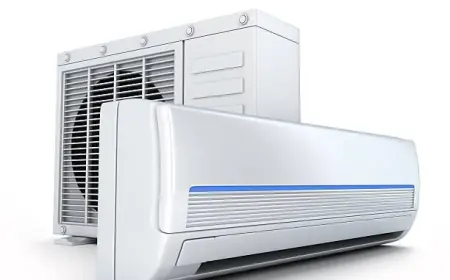7 Whole-Home Purification Options to Boost Your Central HVAC System
HVAC System
A central HVAC system is the heart of your home's climate control, providing comfort throughout the seasons by managing indoor air temperature, humidity, and airflow. However, its ability to maintain a clean and healthy indoor environment depends on the quality of air circulating within the system. With air pollutants like dust, allergens, and bacteria increasingly becoming a concern, it’s essential to explore purification options that can complement your HVAC system, improving indoor air quality and overall health.
Here are seven whole-home purification options that can boost your central HVAC system and enhance the quality of the air you breathe every day:
1. HEPA Filtration Systems
High-Efficiency Particulate Air (HEPA) filters are widely recognized for their ability to capture fine particles. While standard HVAC filters catch larger debris like dust and hair, HEPA filters go further by trapping 99.97% of airborne particles as small as 0.3 microns, including pollen, mold spores, and even certain bacteria and viruses.
Benefits:
- Superior filtration: HEPA filters effectively remove smaller particulates, improving the air quality for allergy sufferers or those with respiratory conditions.
- Enhanced HVAC performance: HEPA filters can help protect your HVAC system from buildup that might impair its efficiency, though it may require a system upgrade to handle the denser filter material.
Considerations:
- HVAC compatibility: Standard HVAC systems often need a modification to incorporate a HEPA filter. This could mean installing a bypass system or upgrading your blower motor.
- Cost: HEPA filters are more expensive than standard filters, but their efficiency and health benefits can outweigh the cost.
2. Ultraviolet (UV) Light Purification
Ultraviolet germicidal irradiation (UVGI) is another powerful tool to boost your HVAC system’s purification capability. UV-C light systems are installed within the HVAC ductwork and are designed to kill or neutralize microorganisms like bacteria, viruses, and mold spores by disrupting their DNA.
Benefits:
- Microbial control: UV lights can eliminate pathogens and prevent mold and mildew growth on HVAC components like coils and ductwork, improving the system’s hygiene and air quality.
- Allergen reduction: Reducing mold and bacteria in the system can greatly help those with allergies or asthma.
Considerations:
- Installation costs: UV-C systems are a higher upfront investment, though their ability to reduce bio-growth and improve air quality offers long-term health and system efficiency benefits.
- Maintenance: The bulbs need to be replaced annually to remain effective.
3. Electrostatic Air Filters
Electrostatic filters work by using static electricity to attract and trap particles from the air as it passes through your HVAC system. Unlike traditional filters, these do not rely solely on dense filter materials but on an electric charge that pulls dust, pollen, and other particles out of the air.
Benefits:
- Reusable: Electrostatic filters are washable and reusable, making them a cost-effective long-term option.
- Improved air quality: They can capture particles that standard filters might miss, leading to cleaner air and fewer allergens.
Considerations:
- Filtration effectiveness: While effective at capturing large particles, electrostatic filters may not be as efficient as HEPA filters in removing smaller pollutants like viruses and fine dust.
- Maintenance: Regular cleaning is necessary to maintain effectiveness, as dust buildup can reduce performance.
4. Activated Carbon Filters
Activated carbon filters, also known as charcoal filters, use highly porous carbon to absorb and neutralize volatile organic compounds (VOCs), odors, smoke, and certain gases that other types of filters might miss. These filters are especially useful for households with smokers, pets, or exposure to chemicals like cleaning products and paint fumes.
Benefits:
- Odor control: Activated carbon effectively removes unwanted odors, ensuring fresh-smelling air throughout your home.
- Chemical absorption: Carbon filters absorb harmful gases and chemicals, which helps reduce indoor pollution from everyday household activities.
Considerations:
- Replacement frequency: Carbon filters need to be replaced more frequently than traditional filters, often every three to six months, depending on indoor air quality.
- Not for particulates: These filters are excellent for gas and odor control but don’t capture particulate matter, so they should be paired with a particulate filter like a HEPA filter for comprehensive air purification.
5. Whole-House Humidifiers
While not a traditional air purifier, whole-house humidifiers can significantly enhance indoor air quality by maintaining optimal humidity levels. Balanced humidity not only prevents the growth of mold and bacteria but also reduces dust, allergens, and static electricity, making your home more comfortable and your HVAC system more efficient.
Benefits:
- Prevents dryness: Maintaining indoor humidity between 30-50% can prevent dryness in the skin, throat, and nasal passages.
- Improved HVAC efficiency: Proper humidity levels help your HVAC system work more efficiently in both heating and cooling, which can reduce energy consumption.
Considerations:
- Installation: A whole-house humidifier typically needs to be integrated into the ductwork of your HVAC system.
- Maintenance: Like any other HVAC accessory, humidifiers require regular cleaning and maintenance to prevent mold or mineral buildup.
6. Air Ionizers
Ionizers or ion-generating air purifiers work by emitting negatively charged ions into the air. These ions attach to airborne particles, such as dust, smoke, and pollen, causing them to become heavy and fall out of the air or get captured by a filter. Some ionizers are built directly into HVAC systems to offer continuous air purification.
Benefits:
- Efficient particle removal: Ionizers can remove microscopic particles that other filters may miss, helping improve air quality in homes with allergens.
- Quiet operation: Ionizers often operate quietly without disrupting the normal function of your HVAC system.
Considerations:
- Ozone production: Some ionizers produce trace amounts of ozone, which can be a lung irritant. Always check for models that have been certified as ozone-free or low-ozone.
- Particle settling: While ionizers can remove particles from the air, they don’t trap them in a filter, so these particles may settle on surfaces around your home and require cleaning.
7. Energy Recovery Ventilators (ERVs)
Energy Recovery Ventilators (ERVs) are an advanced system that not only purifies your indoor air but also improves the ventilation of your home. ERVs expel stale indoor air while simultaneously bringing in fresh outdoor air, passing both through a heat exchanger to balance temperature and humidity levels. This helps to reduce the concentration of indoor pollutants while minimizing energy loss.
Benefits:
- Fresh air supply: ERVs provide a continuous flow of fresh air while also filtering out pollutants, allergens, and excess moisture.
- Energy efficiency: By recovering energy from the exhaust air, ERVs reduce the load on your HVAC system, leading to potential energy savings.
- Humidity control: ERVs also help regulate indoor humidity levels, reducing the likelihood of mold and mildew growth.
Considerations:
- Installation cost: ERVs are more expensive than basic purification systems and require professional installation, but their long-term benefits in air quality and energy efficiency can justify the cost.
- Space requirements: They require space within your HVAC system or ductwork to be properly installed and operated.
Air purification systems are essential components for enhancing indoor air quality, particularly in homes equipped with central HVAC systems. These systems can include a variety of technologies, such as multi-stage filtration, UV light, and ionization, all designed to reduce airborne pollutants effectively. By integrating air purifiers into your HVAC setup, you can capture dust, allergens, smoke, and volatile organic compounds (VOCs), ensuring a healthier living environment. Many modern air purification systems also offer smart features, allowing you to monitor air quality in real-time and adjust settings accordingly. Investing in a reliable air purification system can significantly improve your home's overall air quality and well-being.
Air Duct Cleaning and Sealing
Regular air duct cleaning and sealing are essential for maintaining the efficiency of your HVAC system and improving indoor air quality. Over time, dust, allergens, and debris accumulate in the ductwork, hindering airflow and circulating pollutants throughout your home. A professional duct cleaning service can effectively remove these contaminants, reducing the risk of respiratory issues and enhancing the overall comfort of your living space. Additionally, sealing any leaks in the ducts ensures that conditioned air travels efficiently, preventing energy waste and lowering utility bills. Consider scheduling regular air duct maintenance to keep your HVAC system operating at its best.
Conclusion
Enhancing your central HVAC system with whole-home purification options can significantly improve indoor air quality, making your living environment healthier, more comfortable, and energy-efficient. From advanced filtration systems like HEPA filters and activated carbon to UV light technology and energy recovery ventilators, each solution offers unique benefits. Choosing the right combination depends on your home's specific needs, whether you're targeting allergens, odors, humidity control, or microbial contamination. Properly integrating these options with regular maintenance of your HVAC system can ensure clean air throughout your home year-round.
Watch this Web: joripress.com for more!
What's Your Reaction?
 Like
0
Like
0
 Dislike
0
Dislike
0
 Love
0
Love
0
 Funny
0
Funny
0
 Angry
0
Angry
0
 Sad
0
Sad
0
 Wow
0
Wow
0




















































